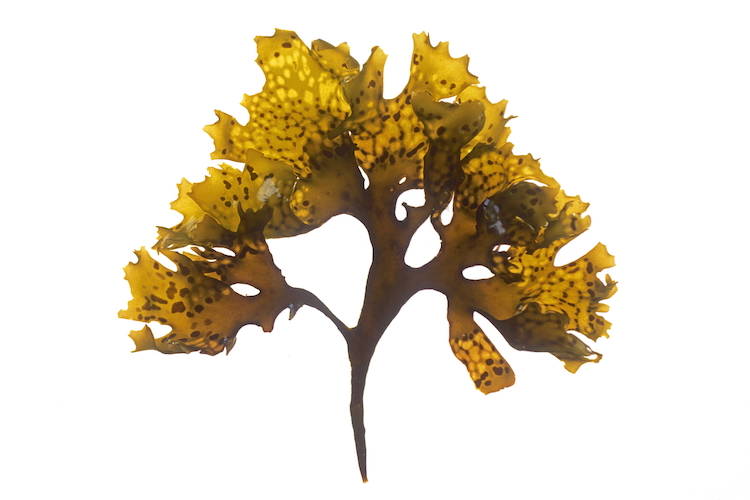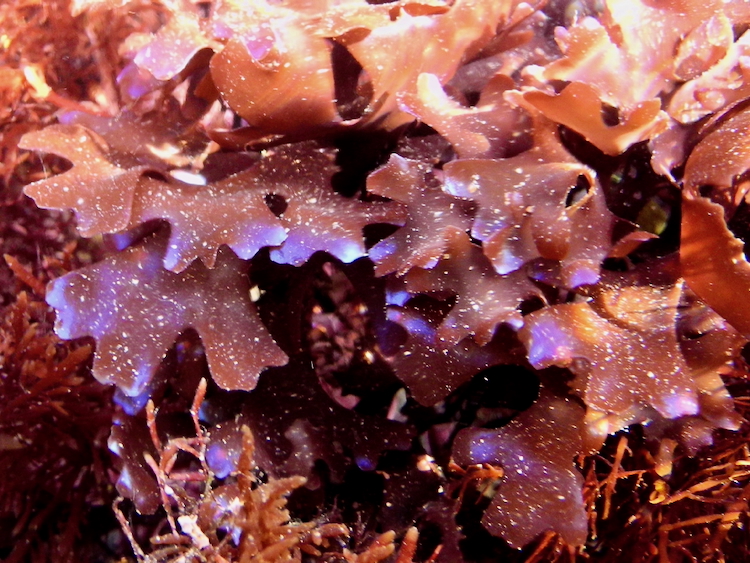Chondrus crispus Stackhouse
Fact Sheet (Download PDF)
Common names: Irish Moss, Carragheen, Carrageen,
Carrageen Moss (Eng.), Mousse d'Irlande (French),
Irisch Moos (German),
Carraigín (Irish)
Description: Cartilaginous, dark purplish-red fronds,
female plants sometimes iridescent at the apices under water (bottom right) when in good condition and turning almost completely
greenish-yellow in upper-shore rock-pools; to 150 mm
high. Stipe compressed, narrow, expanding gradually onto a flat,
repeatedly dichotomously branched blade, in tufts from a discoid
holdfast. Axils rounded, apices blunt or subacute, frond thicker
in centre than margins. Very variable in breadth of segments.
Habitat: On rocks (above), in pools, lower intertidal and
shallow subtidal, widely distributed, abundant.
Variability: This is one of the most varibale species in the North Atlantic in size, colour, branching, broadness of fronds; at one time it was known as Fucus polymorphus.
Usage: A source of carrageenan (a sulphated
polysaccharide), and used to make soups, jellies, etc., and in
Ireland as a remedy for respiratory disorders (colds, influenza
and tuberculosis). The colloquial English name
"Carrageen" was introduced in Ireland about 1840 by a
Mr Todhunter from Donegal and is likely to have been taken from
Carrigeen (or Carrigan) Head in Co. Donegal and not from a town
or townland name in Co. Waterford; however, Carrageen or
Carrigeen (carraigín, Irish: literally "little rock")
is an ver common placename in Ireland. Chondrus crispus plants gathered in the shallow subtidal
of some of the Maritime Provinces of Canada is an important
source of the industrially-important hydrocolloid carrageenan. Irish Moss has been used in Ireland since the beginning of the 19th century as a folk remedy for respiratory ailments. Its use was exported to New England in the USA by famine emigrees in the mid-19th century and was expanded to include sizing of ropes and cooking. Small amounts are still collected in Ireland for cooking and as a health drink. In Canada, Acadian Seaplants grow colour and morphological variants of this species, which is sold dried as a novelty salad (Hana Tsunomata®).
Similar species: In Ireland, Mastocarpus stellatus is frequently collected with Chondrus crispus and sold as
a mixture under the name Carrageen or Irish Moss.
Note: in Germany there is currently a line of
personal toiletries known as Irisch Moos.
Link: AlgaeBase
Photographs © M.D. Guiry



-
 BioAtlantis
provides sustainable technologies from the sea to enhance
plant, animal and human health.
BioAtlantis
provides sustainable technologies from the sea to enhance
plant, animal and human health.
-
 Connemara Organic Seaweed Company
provide hand harvested, sustainable, kelp and seaweed products
for human consumption through health supplements and edible
products.
Connemara Organic Seaweed Company
provide hand harvested, sustainable, kelp and seaweed products
for human consumption through health supplements and edible
products.
-
 Emerald Isle Organic Irish Seaweed.
A family business producing seaweed as supplements,
cooking, gardening and bath products.
Emerald Isle Organic Irish Seaweed.
A family business producing seaweed as supplements,
cooking, gardening and bath products.
-
 Irish Seaweeds Ltd
are suppliers of 100% natural hand-harvested seaweeds and
edible sea vegetable products from Ireland.
Irish Seaweeds Ltd
are suppliers of 100% natural hand-harvested seaweeds and
edible sea vegetable products from Ireland.
